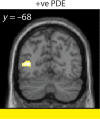Individual Differences in Adult Reading Are Associated with Left Temporo-parietal to Dorsal Striatal Functional Connectivity
- PMID: 26400921
- PMCID: PMC5028000
- DOI: 10.1093/cercor/bhv214
Individual Differences in Adult Reading Are Associated with Left Temporo-parietal to Dorsal Striatal Functional Connectivity
Abstract
Reading skills vary widely in both children and adults, with a number of factors contributing to this variability. The most prominent factor may be related to efficiency of storage, representation, or retrieval of speech sounds. This phonological hypothesis is supported by findings of reduced activation in poor readers in left hemisphere ventro-lateral prefrontal and temporo-parietal phonological processing regions. Less well explained by phonological theories are reported hyperactivation in prefrontal, striatal, and insular regions. This study investigated functional connectivity of a core phonological processing region, the temporo-parietal junction (TPJ), in relation to reading skill in an adult community sample. We hypothesized that connectivity between TPJ and regions implicated in meta-analyses of reading disorder would correlate with individual differences in reading. Forty-four adults aged 30-54, ranging in reading ability, underwent resting fMRI scans. Data-driven connectivity clustering was used to identify TPJ subregions for seed-based connectivity analyses. Correlations were assessed between TPJ connectivity and timed-pseudoword reading (decoding) ability. We found a significant correlation wherein greater left supramarginal gyrus to anterior caudate connectivity was associated with weaker decoding. This suggests that hyperactivation of the dorsal striatum, reported in poor readers during reading tasks, may reflect compensatory or inefficient overintegration into attention networks.
Keywords: caudate; functional connectivity; reading; temporo-parietal junction.
© The Author 2015. Published by Oxford University Press. All rights reserved. For Permissions, please e-mail: journals.permissions@oup.com.
Figures





References
Publication types
MeSH terms
Grants and funding
LinkOut - more resources
Full Text Sources
Other Literature Sources

